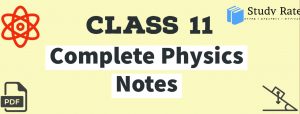Preparing for the Joint Entrance Exam (JEE) can be a daunting task. With so many subjects to cover and so many topics to study, it can be challenging to know where to start. One essential topic in the JEE Mains syllabus is the Magnetism and Matter. In this article, we will provide 50+ MCQ questions on the Magnetism and Matter, along with detailed solutions to help you prepare for the JEE Mains exam.
These 50+ MCQ questions are selected by the experts of studyrate.in and these are more difficult questions, which will help you to better understand Magnetism and Matter JEE Mains MCQ Questions with Answers.
Magnetism and Matter JEE Mains MCQ
Which of the following is an example of a ferromagnetic material?
A) Copper
B) Aluminum
C) Iron
D) Silver
In a paramagnetic material, the magnetic moments:
A) Align parallel to the external magnetic field
B) Align antiparallel to the external magnetic field
C) Do not align with the external magnetic field
D) Can align in any direction
The Curie temperature is the temperature at which a ferromagnetic material:
A) Becomes paramagnetic
B) Becomes diamagnetic
C) Loses its magnetic properties
D) Becomes antiferromagnetic
The phenomenon of hysteresis occurs in:
A) Ferromagnetic materials
B) Paramagnetic materials
C) Diamagnetic materials
D) Superconducting materials
The magnetic moment of a current loop depends on:
A) The current passing through the loop
B) The shape and size of the loop
C) The orientation of the loop with respect to the magnetic field
D) All of the above
The magnetic susceptibility of a diamagnetic material is:
A) Positive
B) Negative
C) Zero
D) Infinity
The magnetic field inside a uniformly magnetized bar magnet is:
A) Zero
B) Uniform
C) Increasing towards the center
D) Decreasing towards the center
The permeability of a diamagnetic material is:
A) Greater than vacuum permeability
B) Less than vacuum permeability
C) Equal to vacuum permeability
D) Variable depending on the temperature
The susceptibility of a paramagnetic material is:
A) Positive and small
B) Positive and large
C) Negative and small
D) Negative and large
The magnetic field at the center of a current loop is:
A) Zero
B) Maximum
C) Minimum
D) Infinity
The magnetic field inside a uniformly magnetized sphere is:
A) Zero
B) Uniform
C) Increasing towards the center
D) Decreasing towards the center
The magnetic moment of an atom arises due to:
A) The spin of the electrons
B) The orbital motion of the electrons
C) Both the spin and orbital motion of the electrons
D) The protons and neutrons in the nucleus
The magnetization of a material is defined as:
A) The total magnetic moment per unit volume of the material
B) The alignment of magnetic domains in the material
C) The magnetic field produced by the material
D) The ability of the material to retain magnetism
The magnetic field inside a uniformly magnetized cylinder is:
A) Zero
B) Uniform
C) Increasing towards the center
D) Decreasing towards the center
The susceptibility of a ferromagnetic material is:
A) Positive and small
B) Positive and large
C) Negative and small
D) Negative and large
The magnetic field at a point outside a long straight current-carrying wire is:
A) Zero
B) Uniform
C) Decreasing with distance
D) Increasing with distance
The magnetic field inside a uniformly magnetized ellipsoid is:
A) Zero
B) Uniform
C) Increasing towards the center
D) Decreasing towards the center
The magnetic field inside a current-carrying solenoid is:
A) Zero
B) Uniform
C) Increasing towards the ends
D) Decreasing towards the ends
The magnetic field at the center of a circular current loop is:
A) Zero
B) Maximum
C) Minimum
D) Infinity
The magnetic field inside a uniformly magnetized cube is:
A) Zero
B) Uniform
C) Increasing towards the center
D) Decreasing towards the center
The magnetic field at the center of a uniformly magnetized sphere is:
A) Zero
B) Maximum
C) Minimum
D) Infinity
The magnetic field inside a current-carrying toroid is:
A) Zero
B) Uniform
C) Increasing towards the ends
D) Decreasing towards the ends
The magnetic field at a point on the axial line of a current loop is:
A) Zero
B) Maximum
C) Minimum
D) Infinity
The magnetic field at a point inside a current-carrying circular loop is:
A) Zero
B) Maximum
C) Minimum
D) Infinity
The magnetic field at a point on the equatorial line of a current loop is:
A) Zero
B) Maximum
C) Minimum
D) Infinity
The magnetic field at a point outside a current loop is:
A) Zero
B) Maximum
C) Minimum
D) Infinity
The magnetic field at the center of a current-carrying circular coil is:
A) Zero
B) Maximum
C) Minimum
D) Infinity
The magnetic field at a point on the axis of a current loop is:
A) Zero
B) Maximum
C) Minimum
D) Infinity
The magnetic field at a point on the equatorial plane of a current loop is:
A) Zero
B) Maximum
C) Minimum
D) Infinity
The magnetic field at a point on the axial line of a current loop is:
A) Zero
B) Maximum
C) Minimum
D) Infinity
We hope there JEE MCQ of Class 12 Magnetism and Matter will help you to score an excellent rank in JEE Mains and Advanced. If you have any queries feel free to write in the comments section. We at Study Rate are always ready to serve our students.


